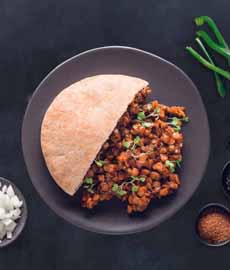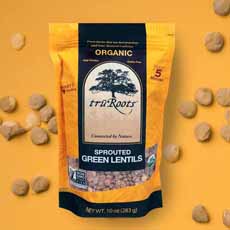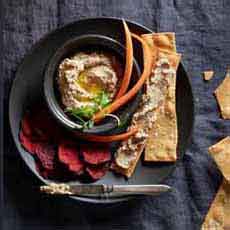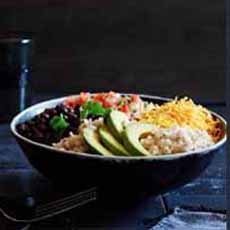
[1] Not justs a side or salad: a sandwich of sprouted green lentils (all photos courtesy Tru Roots).

[2] Any grain or legume can be sprouted. You can find them fresh in health food stores, or dehydrated in a broader selection of markets.

[3] Sprouted bean and lentil dip with chia (Here’s the recipe).

[4] Soup with sprouted mung beans (here’s the recipe).

[5] A grain bowl with sprouted rice (here’s the recipe).
|
|
What are sprouted grains, a colleague asked, during a conversation on better-for-you foods to embrace in 2018.
Sprouting is a culinary technique that dates back more than 5,000 years.
Legumes (beans, peas and lentils), grains and seeds that come into contact with moisture will sprout naturally—and accidentally. Man figured out how to do it deliberately.
In the last 100 years or so, as the superior nutritional benefits have been recognized, the sprouted group become a fast-growing sector of the category.
You can find them fresh in health food stores, or dehydrated (dried) in a broader selection of markets.
WHAT IS SPROUTING?
The goal of sprouting is to break down—split open, but not remove—the protective bran coating. This helps to unlock nutrients. Sprouted grains are still whole grains.
The grains, legumes or seeds are soaked in water and allowed to germinate long enough to sprout. The bran layer splits open as the sprout emerges. If the sprout is left alone, it turns into a plant.
But stop the action when it’s just sprouted—the stage between being a grain or legume and being a new plant—and it retains the increased nutrition it needs grow into a full plant.
Some call that extra hit “supercharged.” That’s why sprouted grains, legumes and seeds have been embraced by people seeking ways to enhance their nutritional intake.
THE BENEFIT OF SPROUTED GRAINS-LEGUMES-SEEDS
When they sprout, nutritional “magic” happens. The sprouted foods:
Have less calories and fat.
Have a higher proportion of protein and other nutrients (B vitamins, vitamin C, folate, fiber, lysine and other essential amino acids).
Are easier to digest, including for people with gluten intolerance (sprouting breaks down starches into simple sugars).
Increase the availability of vitamins, minerals and omega-3 fatty acids.
Have triple the amount of soluble fiber.
Have a low glycemic index (diabetic friendly).
Are more flavorful (with a slightly nutty flavor).
Cook faster.
According to the Whole Grains Council, research on sprouted grains has documented a wide range of health benefits for different sprouted grains. Just a few:
Sprouted barley decreases blood pressure.
Sprouted brown rice fights diabetes and reduces risk of cardiovascular disease.
Sprouted buckwheat protects against fatty liver disease.
WHEN TO SERVE WHOLE GRAINS
You can serve whole grains for any repast of the day. In addition to purchasing prepared foods like breads, wraps and pizza crusts, you can use whole grain flour to bake, make pasta, etc.
Some examples:
Breakfast: pancakes, toast, waffles
Lunch: grain bowls, sandwiches, soups
Dinner: chicken or fish with sprouted chia breading, pasta, risotto, sides
Dessert: baked goods, baked apples with sprouted quinoa, rice pudding
Snacks: chocolate-quinoa truffles, dips and spreads, smoothies
Check out these recipes from Tru Roots.
MORE RECIPES
Some sprouted grain recipes from the Whole Grains Council and Tru Roots:
Cinnamon Banana Sprouted Rice Pudding
Shrimp Stir Fry With Sprouted Brown Rice
Sprouted Bread & Rolls
Sprouted Brown Rice Risotto
Sprouted Coconut Waffles
Sprouted linguine With Tomatoes & Fresh Herbs
|







